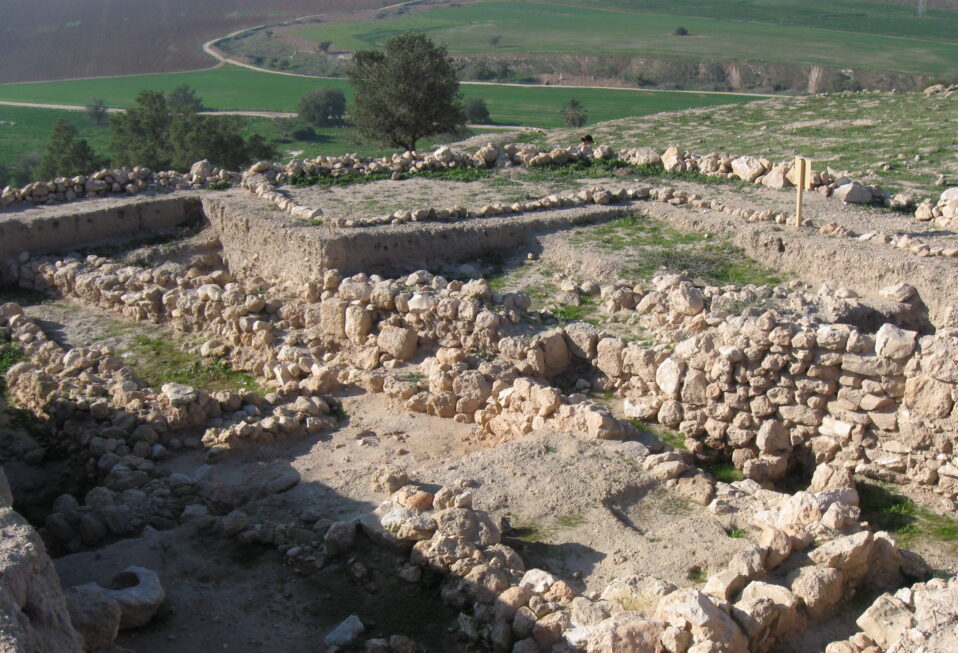Famous as the hometown of Goliath, Gath of the Philistines sits at the opening of the Elah Valley into the coastal plain (1 Samuel 17) in the northwestern Judean lowlands. Archaeological excavations, as well as ancient sources (like the Bible) have led to the identification of the site of Gath with a place known as Tel es-Safi. Gath was one of the five cities of the Philistine Pentapolis, along with Gaza, Ashkelon, Ashdod, and Ekron. The Bible mentions Gath more than any other Philistine city.
It serves as a key city within the narrative of the wandering of the Ark of the Covenant (1 Samuel 5). Most of the biblical references to Gath come from the stories relating to David. He fought Goliath from Gath (1 Samuel 17); he escaped from Saul fleeing to Achish the king of Gath (1 Samuel 21 and 27). Ittai the Gittite (meaning he’s from Gath) served as the commander of David’s trusted warriors (2 Samuel 15).
Gath’s prominence diminished during the later Old Testament period. 2 Kings 12:17 mentions the capture of Gath by Hazael of Aram (around 830 B.C.). The prophet Amos spoke about the state of Gath’s destruction (6:2), most likely as a result of the destruction of Hazael. In later biblical texts where the Philistine cities are mentioned, Gath is not, indicating that it was no longer important by the 8th century B.C.
Excavations at Gath (Tel es-Safi) indicate that in the Late Bronze Age a distinct cultural change happened with the appearance of Philistine culture. During this period and the early Iron Age, excavations reveal that Gath was a large urban center. Up until the destruction of Gath as a result of Gath’s conquest by Hazael, the site grew reaching its zenith in the 10th-9th centuries B.C. It covered 16 to 20 acres, with an upper and lower city making it one of the largest sites in this period within the Levant (modern Syria, Lebanon, Jordan, Israel, and the West Bank). Excavators discovered evidence of Hazael’s siege and conquest including a destruction layer throughout the site.
Scholars have recognized that the origins of the Philistines lay within the Aegean world. An inscription discovered in the excavations of Gath have underscored this. The inscription dates to Iron Age IIA and is inscribed with an archaic alphabetic script. It preserves two non-Semitic, Indo-European names with parallels from Mycenaean Greek and Luwian. It is the earliest decipherable Philistine text. It shows that the Philistines used Aegean scripts for their early writing, and that the Philistine language had Indo-European roots.
The size of the site of Gath and the excavations carried out there are significant not only for Gath but understanding Philistine culture in general. This gives important background to their appearance within the biblical record.
Marc Turnage is President/CEO of Biblical Expeditions. He is an authority on ancient Judaism and Christian origins. He has published widely for both academic and popular audiences. His most recent book, Windows into the Bible, was named by Outreach Magazine as one of its top 100 Christian living resources. Marc is a widely sought-after speaker and a gifted teacher. He has been guiding groups to the lands of the Bible—Israel, Jordan, Egypt, Turkey, Greece, and Italy—for over twenty years.
Website: WITBUniversity.com
Facebook: @witbuniversity
Podcast: Windows into the Bible Podcast




Post a comment